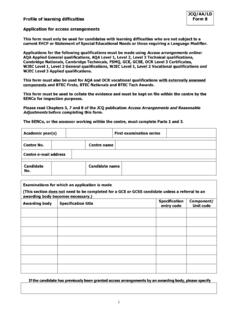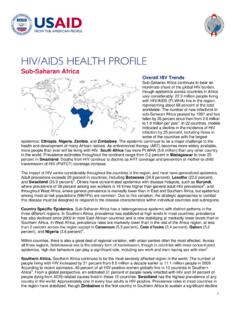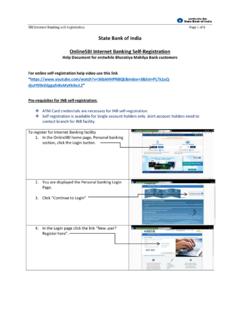Transcription of THE DEGREE QUALIFICATIONS PROFILE - Lumina Foundation
1 THE DEGREEQUALIFICATIONS PROFILEA learning-centered frameworkfor what college graduates should knowand be able to do to earn the associate, bachelor s or master s degree2346688101010121214202021212233333 43644465257 ForewordPrefaceAppendix AAppendix BAppendix CAppendix DAppendix EAppendix FAppendix GIt s time to define quality for students sakeTested and ready: DQP honed by faculty in the fieldExecutive summary The DQP: value, uses, contexts and reinforcementThe need for the DQPUses of the DQPC ontexts for the DQPThe value of the DQP for studentsThe value of the DQP for faculty membersThe value of the DQP for the publicOrganization of the DQPG uidelines for interpreting the DQP proficienciesThe DEGREE QUALIFICATIONS ProfileTools for using the DQPU sing the DQP to develop assignments and assessments The spider webThe grid The matrixWhy proficiency ?The DQP and TuningMore on assignments and assessmentExamples of DQP useDefinitions of key DQP termsQuestions and concernsSources consultedAbout the authorsCONTENTSFOREWORDIT S TIME TO DEFINE QUALITY FOR STUDENTS SAKEJ amie P.
2 Merisotis, President and CEO, Lumina FoundationAs an organization whose sole mission is to increase college attainment, Lumina Foundation has always emphasized educational quality. True, Goal 2025, the goal that drives all of our work, is quantifiable: It calls for 60 percent of Americans to hold high-quality degrees, certificates or other postsecondary credentials by 2025. But it isn t all about numbers. By calling specifically for high-quality credentials, Goal 2025 makes clear that they must reflect rigorous and relevant learning. You see, students don t need just credentials. What they need and what our global economy and democratic society increasingly demand is the learning those credentials signify, the highly developed knowledge and skills that postsecondary education provides. That s why, in the drive to increase college attainment, it s not enough to simply count credentials; the credentials themselves must count. This document, the DEGREE Qualifica-tions PROFILE , is designed to ensure that they do.
3 The DQP isn t exactly a secret. Authored by four eminent scholars and honed by input from experts from all over the globe, the DQP is gaining traction on campuses throughout the nation. In fact, after nearly four years of beta testing at more than 400 colleges and universities in 45 states, the DQP has already proven its value as a tool for fostering and ensuring high-quality learning at the college level. Its specific, well-articulated learning outcomes have made educational pathways more clear and concrete for students at all types of institutions. Paired with the complementary, discipline-specific process of Tuning, the DQP has engaged faculty members in the vital work of improving courses and shaping programs of study at scores of institutions. At others, it has helped focus and streamline the accreditation process. Even in its formative stages, the DQP showed great promise as a practical tool for meaningful change on America s campuses. And now, bolstered by the lessons learned in its years-long beta phase, this new version is poised to fully realize that promise.
4 In fact, we at Lumina see the DQP as a lever that can aid a vital and inevitable shift in American higher education: the shift from a time-based, institution- centric system to one that is based on learning and designed with students needs at the center. This momentous shift shouldn t be news to any of us. It s been underway for years, propelled by several interrelated forces. First of all, the nation s need for talent for individuals who are well equipped to succeed in the modern, global workforce is huge and growing. Employers continually lament the lack not just of specialized technical expertise, but also vital soft skills such as critical thinking, communication and teamwork. In today s world, everyone needs both, and higher education must be the major resource for developing these talented citizens. Second, as higher education s role becomes more critical to society and the economy, policymakers and the public call ever louder for the academy to be more accountable, more productive and more responsible.
5 Today, as never before, institutions must be able to clearly and persuasively articulate the value in terms of specific learning outcomes that their programs add to students lives. Third, as our economy and society demand more talent, the need to link all forms of postsecondary learning in a common system of credentials has become acute. All learning should count, wherever and however it is obtained, and credentials should clearly and transparently represent underlying skills and knowledge. In a knowledge-based world, everyone should have a path forward to further levels of education, whether it s from an associate DEGREE to a bachelor s, from a workforce-relevant certificate to a DEGREE , or from a DEGREE to a career. By defining the learning outcomes that degrees represent, the DQP will help build bridges between all systems of postsecondary learning. Finally, students themselves need this change to happen. College-level learning has become vital to success, but more students than ever before are nontraditional in some way working adults, low-income students, first-generation students, students of color, second-career professionals, you name it.
6 All of them and traditional students, too need a clear path to success. We believe these demands are clear, and that quality in higher education will be better defined. The only real questions are How? and By whom? By using the DQP and its allied Tuning process, institutions can answer those questions in the best possible way. Specifi-cally, the DQP empowers faculty to lead the process to clearly define degrees and credentials according to what really matters: the specific learning outcomes those credentials signify. In short, the DQP shifts the discussion from What are we going to teach? to What should our students learn? What knowledge and skills do they need to thrive? That discussion has already shifted on hundreds of campuses. Now it s time to change the national discussion to scale up use of the DQP and Tuning and apply them broadly as tools to help build a learning-based, student-centered system. Now it s time to go big; millions of students are counting on it.
7 We at Lumina are committed to that course and to the success of those students. We urge you to join the drive to increase college attainment, it s not enough to simply count credentials; the credentials themselves must DQP Lumina FoundationSince its publication in January 2011 as the beta DEGREE QUALIFICATIONS PROFILE , the DQP has proved its usefulness to higher education institutions and associations from coast to coast. More than 400 colleges and universities1 have used the DQP. Its applications have been as diverse as the variety of missions of higher education. The following examples will indicate the range: Many institutions have used the DQP to review and strengthen their general education curricula and enhance connections between general education and the major. Two- and four-year institutions in nine states have collaborated on ways to assess DQP proficiencies in the context of student transfer. Some institutions working to develop discipline-specific learning outcomes (often through Tuning projects) have specified links to DQP proficiencies.
8 Some institutions have implemented a reorientation of their mission and curriculum in light of the DQP. Some institutions with existing statements of learning outcomes have used the DQP in a gap analysis to determine the inclusiveness, sufficiency and distinctive strengths of their statements. Some institutions have used the DQP as a platform for discussions with employers and other stakeholders about needs and expectations. Some institutions have created model assignments for their students in the light of DQP proficiencies. Though this formal release of the DQP reflects much that has been learned through experience with the earlier beta version, this document is more an enhancement than a revision. The fundamental strength of the DQP succinct, active definitions of what DEGREE recipients should know and be able to do at each DEGREE level remains unchanged. Those engaged in implementation or adaptation of the DQP may be confident that its structure and contents have not been substantially has changed since the beta version of the DQP was issued in 2011?
9 Informed by significant feedback from the field,2 this edition includes new proficiencies addressing ethical reasoning and global learning, strengthened statements on quantitative reasoning, and more explicit attention to research. It now highlights analytical and cooperative approaches to learning that transcend specific fields of study. It provides guidance on integrating the development of students intellectual skills with their broad, specialized, applied and civic learning. And, in response to explicit requests from the field, it points to resources that support the assessment of DQP proficiencies. This edition of the DQP thus builds on the success of its beta edition to offer an even more useful, flexible and practical guide for what college graduates should know and be able to do when awarded the associate, bachelor s or master s DEGREE . Future editions of the DQP will be published on a regular basis, as revisions are called for by the field, but the goal of the DQP throughout future editions will continue unchanged to be a useful, flexible and practical tool to define postsecondary degrees in the through the demonstration and documentation of student learning, regardless of the student s field of study.
10 Users are asked to relay suggestions for improving the DQP to: AND READY: DQP HONED BY FACULTY IN THE FIELD1 References to colleges and universities include community colleges, junior colleges and nontraditional The DQP has been used and tested by more than 400 colleges and universities, four of the seven regional accrediting associations and several constituency organizations including the Council of Independent Colleges, the American Association of State Colleges and Universities, and the Association of American Colleges and Foundation DQP 3 With the assistance of the original authors, many expert reviewers and faculty colleagues throughout the , Lumina Foundation now releases its DEGREE QUALIFICATIONS PROFILE . Reflecting years of wide-scale and diverse applications of a beta version, the DQP provides a baseline set of reference points for what students should know and be able to do for the award of associate, bachelor s and master s degrees, regardless of their fields of study.








